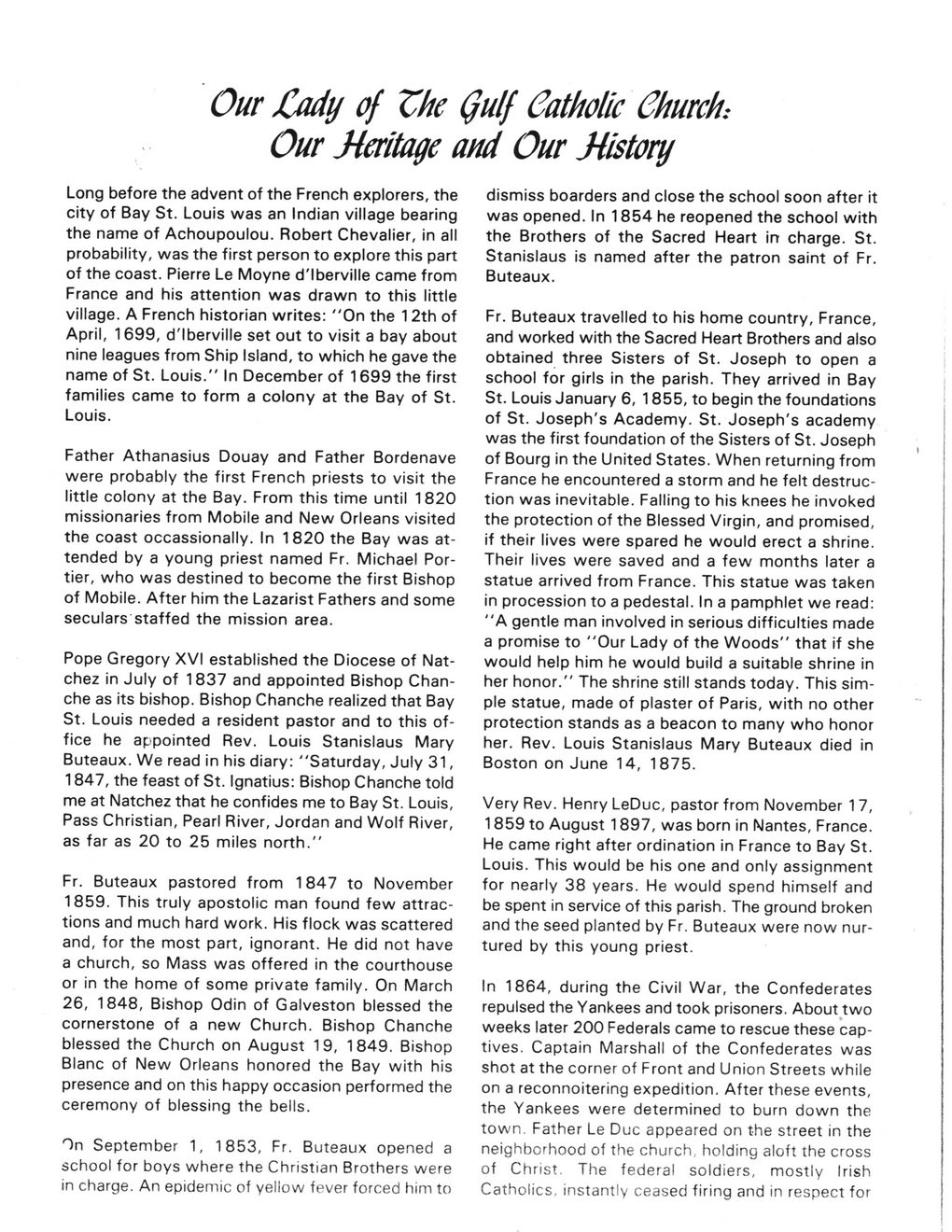This text was obtained via automated optical character recognition.
It has not been edited and may therefore contain several errors.
Our Cady of Zhe Qulf Catholic Church: Our Heritage and Our History Long before the advent of the French explorers, the city of Bay St. Louis was an Indian village bearing the name of Achoupoulou. Robert Chevalier, in all probability, was the first person to explore this part of the coast. Pierre Le Moyne d'lberville came from France and his attention was drawn to this little village. A French historian writes: "On the 1 2th of April, 1699, d'lberville set out to visit a bay about nine leagues from Ship Island, to which he gave the name of St. Louis.” In December of 1699 the first families came to form a colony at the Bay of St. Louis. Father Athanasius Douay and Father Bordenave were probably the first French priests to visit the little colony at the Bay. From this time until 1820 missionaries from Mobile and New Orleans visited the coast occassionally. In 1820 the Bay was attended by a young priest named Fr. Michael Por-tier, who was destined to become the first Bishop of Mobile. After him the Lazarist Fathers and some seculars staffed the mission area. Pope Gregory XVI established the Diocese of Natchez in July of 1837 and appointed Bishop Chan-che as its bishop. Bishop Chanche realized that Bay St. Louis needed a resident pastor and to this office he appointed Rev. Louis Stanislaus Mary Buteaux. We read in his diary: "Saturday, July 31, 1847, the feast of St. Ignatius: Bishop Chanche told me at Natchez that he confides me to Bay St. Louis, Pass Christian, Pearl River, Jordan and Wolf River, as far as 20 to 25 miles north." Fr. Buteaux pastored from 1847 to November 1859. This truly apostolic man found few attractions and much hard work. His flock was scattered and, for the most part, ignorant. He did not have a church, so Mass was offered in the courthouse or in the home of some private family. On March 26, 1848, Bishop Odin of Galveston blessed the cornerstone of a new Church. Bishop Chanche blessed the Church on August 19, 1849. Bishop Blanc of New Orleans honored the Bay with his presence and on this happy occasion performed the ceremony of blessing the bells. On September 1, 1853, Fr. Buteaux opened a school for boys where the Christian Brothers were in charge. An epidemic of yellow fever forced him to dismiss boarders and close the school soon after it was opened. In 1854 he reopened the school with the Brothers of the Sacred Heart in charge. St. Stanislaus is named after the patron saint of Fr. Buteaux. Fr. Buteaux travelled to his home country, France, and worked with the Sacred Heart Brothers and also obtained three Sisters of St. Joseph to open a school for girls in the parish. They arrived in Bay St. Louis January 6, 1855, to begin the foundations of St. Joseph's Academy. St. Joseph's academy was the first foundation of the Sisters of St. Joseph of Bourg in the United States. When returning from France he encountered a storm and he felt destruction was inevitable. Falling to his knees he invoked the protection of the Blessed Virgin, and promised, if their lives were spared he would erect a shrine. Their lives were saved and a few months later a statue arrived from France. This statue was taken in procession to a pedestal. In a pamphlet we read: "A gentle man involved in serious difficulties made a promise to "Our Lady of the Woods" that if she would help him he would build a suitable shrine in her honor." The shrine still stands today. This simple statue, made of plaster of Paris, with no other protection stands as a beacon to many who honor her. Rev. Louis Stanislaus Mary Buteaux died in Boston on June 14, 1875. Very Rev. Henry LeDuc, pastor from November 1 7, 1859 to August 1897, was born in Nantes, France. He came right after ordination in France to Bay St. Louis. This would be his one and only assignment for nearly 38 years. He would spend himself and be spent in service of this parish. The ground broken and the seed planted by Fr. Buteaux were now nurtured by this young priest. In 1864, during the Civil War, the Confederates repulsed the Yankees and took prisoners. About two weeks later 200 Federals came to rescue these captives. Captain Marshall of the Confederates was shot at the corner of Front and Union Streets while on a reconnoitering expedition. After these events, the Yankees were determined to burn down the town. Father Le Due appeared on the street in the neighborhood of the church, holding aloft the cross of Christ. The federal soldiers, mostly Irish Catholics, instantly ceased firing and in respect for

Our Lady of the Gulf Church Document (018)